The Wooden Collection
Antique Seal Stamps Crafted from Precious Woods, including Ebony, Walnut, and Rosewood
This antique stamp belonged to a member of the French de Buissy family, a lineage established in Ponthieu (Somme) from at least the late sixteenth century. At the close of the seventeenth century the family acquired the seigneury of Long, where Honoré-Charles de Buissy commissioned the present château around 1733. The design was entrusted to the architect Charles-Étienne Briseux, noted for his mastery of elegant classical country houses. Conceived not as a fortress but as a refined maison de plaisance, the residence embodied the taste and ambition of a provincial noble family intent on affirming its social standing through architecture. Its opulent decoration and costly embellishments, which far exceeded practical requirements, earned it in popular memory the name "Folie de Buissy".
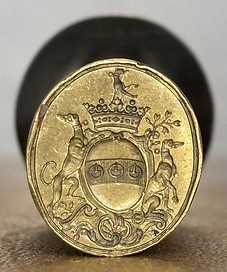
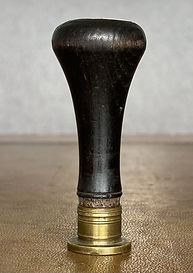
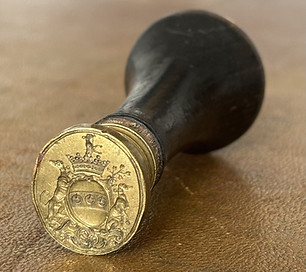
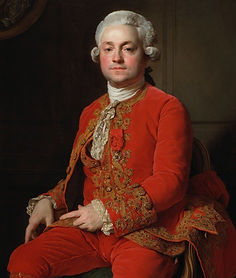.jpg)
Portrait of Pierre de Buissy (1737-1787)
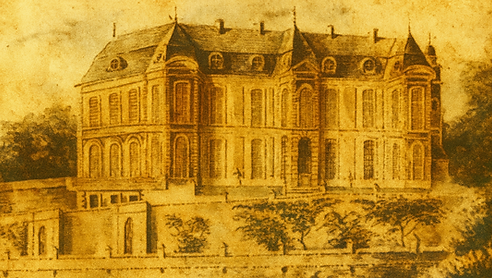
The Chateau de Long, nicknamed "Folie de Buissy"
An unlikely match following intriguing research...
The alliance coat of arms on this stamp caught my attention. On the dexter (right) side of the engraving appear arms very similar to that of Jacques Imbert-Colomes: D’azur, au croissant d’argent, surmonté d’un soleil d’or. Jacques Imbert-Colomes was French, but ended his life in Somerset, in the southwest of England. He left four children. On the sinister (left) side, we see arms that correspond to the Frankland family, Baronets of Thirkleby in North Yorkshire. One might speculate that a male descendant of Jacques Imbert-Colomes could have married into the Frankland family, especially since certain members of the Franklands did reside in Somerset, such as Sir Thomas Frankland, 5th Baronet (1718-1784). Such a marriage would support the idea that this seal stamp once belonged to a couple uniting the two families. However, this proves rather unlikely. Indeed, the dexter position of the assumed Imbert-Colomes arms would indicate that it is the husband that belonged to the French family. Yet Jacques Imbert-Colomes had only one son who never married. On the Frankland side, there is no trace of a marriage with a descendant of Jacques Imbert-Colomes. Their alliances were primarily with members of the English and American aristocracy. Thus, while the investigation is fascinating, the possibility of a marital union between the two families must be regarded as improbable.






Jacques Imbert-Colomes

Sir Thomas Frankland, 6th baronet

The daughters of Sir Thomas Frankland



This old seal stamp comes from Italy. The engraved arms can be described as "Per fess: in chief Or, an eagle displayed crowned; in base Argent, a curved feather". The crowned eagle in Italian heraldry refers to imperial allegiance or concession, often indicating that the family has been granted privileges by the Holy Roman Emperor. It thus appears frequently in arms of Lombard, Venetian, and South Tyrolean origin, regions once under imperial influence. The curved feather (or plume), however, is much less common in heraldry, especially in Italian arms. Feathers in heraldry can represent ostrich feathers, symbolizing obedience or noble status. It can also refer to quills or pens, sometimes used by notaries, scholars, or families with administrative distinction, often depicted straight, not curved. A single curved feather, as in this case, is quite unusual. It might have been a personal emblem rather than a traditional heraldic charge, perhaps alluding to intellect, artistic sensibility, or even a play on the family’s name (arme parlante).
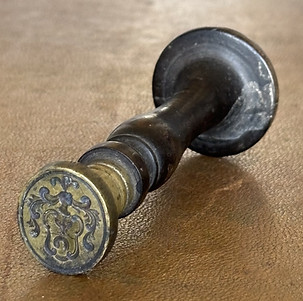

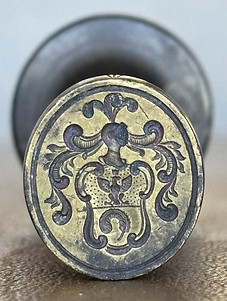



This wooden stamp may have belonged to Gabriel Charles de La Condamine and Augustine Jeanne Marie d’Affry de La Monnoye. The d’Affry de La Monnoye were a branch of the old d’Affry family of Fribourg in Switzerland, a lineage that produced notable military officers and diplomats in French service, among them Louis-Auguste-Augustin, Comte d’Affry (1713 - 1793), Lieutenant General of France and commander of the Swiss Guards. In France, members of the main line were formally recognized with the comital title by the King, often in reward for military service. In collateral branches such as de La Monnoye, however, the title was sometimes used as a titre de courtoisie, a courtesy title rather than a formally registered comté. On Augustine’s arms (Argent, three chevrons Sable), the addition of a red border may represent a mark of cadency, which makes it slightly different from the arms of the rest of the family.






Charles-Marie de la Condamine


Arms of Louis Auguste Augustin d’Affry, Comte d'Affry
Portrait of Louis Auguste Augustin d'Affry
This stamp belonged to François Léon Boscal de Réals de Mornac. The arms correspond to those of his family, from Saintonge and Languedoc, with a branch in Brittany. Rietstap’s Armorial Général notes two variants of their arms, one with an azure field, the other with gules. Both variants share the combination of an uprooted oak, a fleur-de-lis, and two crescents for the Brittany branch. The attribution to François Léon is supported by the presence of the engraved Brassard de Bordeaux, a French military decoration created on 5 June 1815 by the Duke of Angoulême. The inscription 'BORDEAUX 12 MARS 1814' commemorates the day the city of Bordeaux declared allegiance to the Bourbons. Loyalists who supported the Restoration were awarded the Brassard de Bordeaux, a white armband bearing this motto. François Léon Boscal de Réals de Mornac is known to have been among its recipients.





François Léon Boscal de Réals de Mornac
(1783-1858)


The Brassard de Bourdeaux
Duke of Angoulême, wearing the Brassard de Bordeaux, among other decorations
This stamp was acquired from an antique dealer in Nice, France. Research has not yet made it possible to identify the original owner with certainty. However, careful analysis suggests a 17th–18th-century alliance between southern French nobility - possibly a branch of the de Méjanès family - and a German family bearing an eagle on an Or field. The seal may have belonged to a descendant of that union, featuring quartered arms that combine the heraldic symbols of both lineages.



This seal stamp belonged to James Wentworth Buller (1798 - 1865), who was a British Whig politician of Downes, Crediton, Devon, and who served as Member of Parliament for Exeter from 1830 to 1835, and later for North Devon from 1857 until his death in 1865. He was the son of James Buller (1766‑1827) of Downes and Anne Buller, and grandson of another James Buller (1717-1765). He married Charlotte Juliana Jane Howard‑Molyneux‑Howard. The Buller family of Downes belonged to the English landed gentry, an old and influential family but not part of the titled nobility. While their social position was prominent, they were not peers of the realm. However, related branches of the same wider family were indeed ennobled: the Buller baronets of Churston Court (1790) and of Trenant Park (1808), the former later elevated to Barons Churston. Their coat of arms, recorded in heraldic sources, is: Sable, on a cross argent quarter-pierced of the field, four eagles displayed of the first.





Charlotte Julianna Jane Howard Buller

Arms of James Buller of Shillingham of Cornwall

James Wentworth Buller (1798 - 1865)
This seal stamp, with its beautiful turned wooden handle, belonged to Anatole Ruty, the son of General Charles Étienne François Ruty, Count and Peer of France. Both the father and the son held the same titles - Comte and Pair de France - symbolized in their arms by the mantle of peerage surmounted with the coronets. The engraving of Anatole’s seal shows a subtle difference though: it omits the honorific decorations which are suspended beneath the shield of his father's arms.



While unfortunately the top of the handle of this seal is missing, its engraving is remarkable, and hours of research have been needed to identify its components. Like many Spanish coats of arms, this one brings together the heraldic identity of a noble lineage formed through the union of several prominent families of Spain over many generations. At its center appears the oval shield of Vera de Aragón, surrounded by the arms of Figueroa, Guevara, Zúñiga, and Vargas, reflecting a network of alliances that spread across Castile, Navarre, and the Mediterranean dominions of the Crown of Aragon. Around these arms are the royal emblems - Navarre, León, and Sicily - not as claims to sovereignty, but as symbols of ancestral origin or long-standing service under those kingdoms. The badge of the Immaculate Conception is a devotional mark historically favored by the Spanish aristocracy. The seal therefore represents not a single family, but several noble houses brought together in one bearer who inherited or represented these intertwined lineages. While I still have to identify its exact owner, this seal very plausibly belonged to a member of the Vera de Aragón family, who used the surrounding arms to display his ancestral alliances, while reserving the central escutcheon to assert his own house. The pairing of Vera and Sicily arms inside the escutcheon can point to a Vera de Aragón whose career, honors, or station were closely tied to the Kingdom of Sicily.







Gómez Suárez de Figueroa
Personal heraldic research
Vicente Maria de Vera de Aragon, Duke de la Roca



The Guevara arms in a rare 16th century book of the National Library of Spain
The complex coat of arms of Vera de Aragon, with the Vargas, Zúñiga y Guzmán, Figueroa, and Guevara families
An old and precious engraving of the coat of arms of the House of Zúñiga
Gerry's Collection of Antique Seal Stamps.

